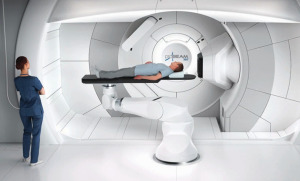by
Lisa Chamoff, Contributing Reporter | November 19, 2020
Varian Medical Systems announced today that the first patient in the world has been treated with FLASH therapy during the start of the first human clinical trial.
The patient was treated at Cincinnati’s Children’s/UC Health Proton Therapy Center using a Varian ProBeam proton therapy system modified to deliver radiation treatment at ultra-high dose rates.
The study, called the FeAsibility Study of FLASH Radiotherapy for the Treatment of Symptomatic Bone Metastases, or FAST-01, is expected to enroll up to 10 patients with bone metastases to evaluate clinical workflow feasibility, treatment-related side effects and efficacy of treatment as assessed by measuring pain relief of trial participants.



Ad Statistics
Times Displayed: 56950
Times Visited: 1656 Ampronix, a Top Master Distributor for Sony Medical, provides Sales, Service & Exchanges for Sony Surgical Displays, Printers, & More. Rely on Us for Expert Support Tailored to Your Needs. Email info@ampronix.com or Call 949-273-8000 for Premier Pricing.
"The prior three years of preparation by the researchers, engineers, clinical and physics teams culminated in a treatment that was completed in the literal 'blink of an eye', and the patient was discharged feeling well," Dr. John Breneman, medical director of the Cincinnati’s Children’s/UC Health Proton Therapy Center, and the trial's principal investigator, told HCB News.
Breneman said the first human trial of FLASH radiotherapy will build a foundation for extending this therapy to other types of cancer treatments, including lung cancer and other malignancies, which are currently in development.
The study was designed by leaders at Varian and multiple centers in the FlashForward Consortium, a 20-member group of institutions from around the world, which includes experts in radiation oncology, translational sciences and medical physics, including at Cincinnati’s Children’s/UC Health Proton Therapy Center and the New York Proton Center.
“Treating the first patient in this FLASH clinical trial is a milestone that many thought was still years ahead of us,” said Kolleen Kennedy, chief growth officer and president of Proton Therapy Solutions at Varian, in a statement.
Dr. John Perentesis, director of the Division of Oncology & Cancer Programs at Cincinnati Children’s, said FLASH has the potential to treat and cure malignancies that respond to radiation but aren’t completely cured at current doses, including pediatric brain tumors like DIPG/pontine glioma and medulloblastoma, sarcomas and neuroblastoma.
A preclinical trial under a partnership with the University of Maryland School of Medicine’s Department of Radiation-Oncology found that mice receiving FLASH therapy had 25 to 30 percent less damage to lung tissue and an average 35 percent decrease in skin dermatitis.
Dr. Charles Simone, II, chief medical officer at the New York Proton Center and a member of the FlashForward Consortium, said physicians are optimistic that the results of the FAST clinical development program will "transform the way the industry approaches treatment.
"FLASH therapy has the potential to be practice-changing and dramatically improve the
experience of cancer care for a new generation of patients," Simone said in a statement. "The launch of the first FLASH clinical trial, a project that has come to fruition after years of intensive study, is an important milestone in the progress of radiation therapy."

